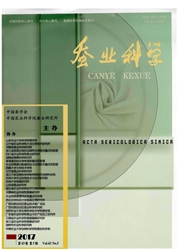

 中文摘要:
中文摘要:
通过分析家蚕自幼虫期到蛹期发育过程中肠上皮细胞的增殖与分化情况,鉴定家蚕中肠干细胞的潜在定位。采用苏木精和伊红(Hematoxylin and Eosin,H&E)染色与4’,6-二脒基-2-苯基吲哚(4’,6-diamidino-2-phenylindole,DAPI)染色追踪变态和发育时期家蚕中肠的形态结构及细胞组成变化,结果显示,幼虫经历蜕皮及变态时,中肠形态结构以及中肠上皮细胞组成均发生明显变化:在幼虫每个龄期的盛食期肠壁较薄,眠前期(蜕皮前)明显变厚,至眠期其厚度达到峰值;中肠上皮层存在柱状细胞(CC)、杯状细胞(GC)和再生细胞(RC)3种细胞,3种类型细胞随龄期逐渐增多,其中各龄期柱状细胞持续增多,至眠期达到峰值,靠近基底膜的小细胞在眠前期增多。利用5-溴脱氧尿嘧啶核苷(5-Bromo-2-deoxyUridine,BrdU)和磷酸化组蛋白(Phospho-histone H3,PHH3)免疫荧光染色检测到中肠上皮细胞,尤其是中肠上皮层靠近基底膜处的小细胞在幼虫各龄眠前期的增殖率最高。同时通过BrdU滞留标记实验在中肠上皮层靠近基底膜处发现了BrdU滞留阳性信号。研究结果发现家蚕幼虫蜕皮时中肠上皮层靠近基底膜处的小细胞发生快速增殖,推测这些小细胞中存在着潜在的家蚕中肠干细胞。
 英文摘要:
英文摘要:
In this study,we indentified the potential location of intestinal stem cells in the silkworm(Bombyx mori) through analysis of proliferation and differentiation of midgut epithelial cells during different developmental stages of larva to pupa.And we observed the morphological structure and cellular component of silkworm midgut during metamorphosis and development of silkworm larvae by Hematoxylin and Eosin(H&E) staining and 4’,6-diamidino-2-phenylindole(DAPI) staining.The results showed that the morphological structure and cellular component of silkworm midgut had remarkable changes in the process of molting and metamorphosis of silkworm larvae.The intestinal wall was thin at full appetite stage of each instar,became thicker before molting,and reached peak value at molting stage.There were three types of cells,namely columnar cells(CC),goblet cells(GC) and regenerative cells(RC),in the midgut epithelium.These three types of cells increased gradually with the advance of larval instar.Among them,the goblet cells increased continuously in all instars and reached peak value at molting stage,while the small cells near basal lamina increased at pre-molting stage.Observation by 5-Bromo-2-deoxyUridine(BrdU) and Phospho-histone H3(PHH3) immunofluorescence staining revealed that midgut epithelial cells,especially the small cells near basal lamina of midgut epithelium,had the highest proliferation rate at pre-molting stage of each instar.Meanwhile,BrdU label retention assay displayed positive signal of BrdU retention in the midgut epithelium near basal lamina.These results demonstrated rapid proliferation of small cells near basal lamina of midgut epithelium during molting of silkworm larvae,suggesting the existence of potential intestinal stem cells in these small cells.
 同期刊论文项目
同期刊论文项目
 同项目期刊论文
同项目期刊论文
 The Histone H3 Methyltransferase G9A Epigenetically Activates the Serine-Glycine Synthesis Pathway t
The Histone H3 Methyltransferase G9A Epigenetically Activates the Serine-Glycine Synthesis Pathway t 期刊信息
期刊信息
